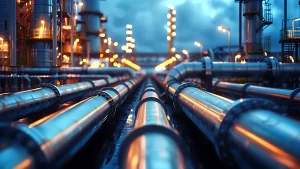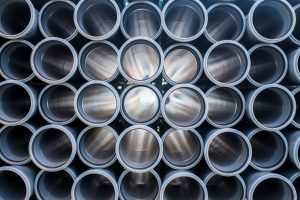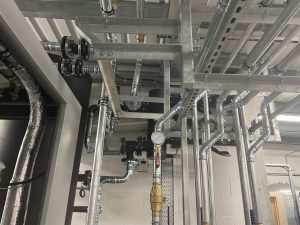In today’s era of heightened environmental awareness and the push for sustainability, the energy efficiency of commercial buildings has taken centre stage.
Among the myriad factors influencing a building’s energy consumption, industrial pipework systems play a pivotal yet often underestimated role.
These intricate networks of pipes, responsible for transporting water, air, and other fluids throughout a structure, are crucial in maintaining operational efficiency and comfort.
This blog delves into how pipework systems significantly contribute to the energy efficiency of commercial buildings, illuminating the synergy between well-designed pipework and sustainable building practices.
Understanding Pipework Systems in Commercial Buildings
Pipework systems are the lifelines of commercial buildings, facilitating the smooth operation of essential services such as heating, ventilation, air conditioning (HVAC), water supply, and waste management.
These systems ensure that occupants are comfortable, safe, and have access to clean water, all while managing the disposal of waste efficiently.
However, the significance of pipework systems extends beyond mere functionality; they are instrumental in a building’s energy consumption profile.
Poorly designed or outdated pipework can lead to significant energy waste, whereas optimised systems can drastically reduce a building’s operational costs and environmental footprint.
Key Ways Pipework Systems Enhance Energy Efficiency
Efficient Distribution
Efficient distribution within pipework systems means ensuring that fluids are transported in the most energy-efficient manner possible.
This involves minimising distances that fluids need to travel, reducing friction and turbulence through well-chosen pipe diameters, and implementing zonal systems to avoid unnecessary heating or cooling of unoccupied areas.
Such measures significantly lower the energy demand on pumps and HVAC systems, leading to lower energy consumption and cost savings.
Insulation
Insulation is a critical factor in preventing energy loss in pipework systems. Properly insulated pipes reduce the need for heating systems to work overtime during winter and cooling systems in summer, directly impacting energy savings.
This not only preserves the intended temperature of transported fluids but also prevents condensation and associated risks of pipe damage, further enhancing the system’s efficiency and longevity.
Material Choices
The material selection for pipework impacts its thermal conductivity and, consequently, its energy efficiency.
Materials such as copper and certain plastics offer beneficial properties, including durability and low thermal conductivity, which help maintain the temperature stability of fluids.
Choosing the right materials can thus play a significant role in reducing energy loss and optimising the overall efficiency of a building’s pipework system.
Leak Prevention
Leaks in pipework systems not only waste water and energy but also compromise the efficiency of the entire system.
Implementing regular maintenance schedules and using smart leak detection technologies can identify and rectify leaks early, preventing minor issues from escalating into major inefficiencies.
This proactive approach is crucial in maintaining an energy-efficient pipework system.
Technological Innovations and Improvements
The advent of smart technology and innovative materials has brought a new dimension to the efficiency of pipework systems.
Modern monitoring systems equipped with sensors can now predict failures, detect leaks, and provide real-time data on system performance.
Such technologies enable building managers to make informed decisions about maintenance and upgrades, ensuring that pipework systems operate at peak efficiency.
Case studies of commercial buildings that have embraced these innovations often showcase significant improvements in energy management, underscoring the potential of technology in transforming traditional pipework systems into models of efficiency.
Best Practices for Maximising Energy Efficiency Through Pipework Systems
To fully realise the energy-saving potential of pipework systems, it is essential to adhere to best practices in their design, installation, and maintenance.
This includes conducting regular energy audits to identify inefficiencies, investing in high-quality insulation, and choosing the most suitable materials for the building’s specific needs.
Additionally, training maintenance staff to recognise and address energy wastage promptly can maintain the efficiency of pipework systems in the long term.
These strategies, when implemented correctly, can significantly reduce energy consumption and contribute to the sustainability goals of commercial buildings.
Conclusion
Pipework systems are more than just conduits for fluids within commercial buildings; they are integral components of a building’s energy efficiency strategy.
By ensuring efficient distribution, proper insulation, judicious material selection, and vigilant leak prevention, these systems can substantially reduce energy consumption and operational costs.
Furthermore, embracing technological innovations and adhering to best practices in pipework management can amplify these benefits, paving the way for more sustainable and cost-effective commercial buildings.
As the world leans into a more energy-conscious future, the role of pipework systems in achieving energy efficiency cannot be overstated, highlighting the need for building owners and managers to consider their pipework infrastructure as a key factor in their overall energy management strategy.








